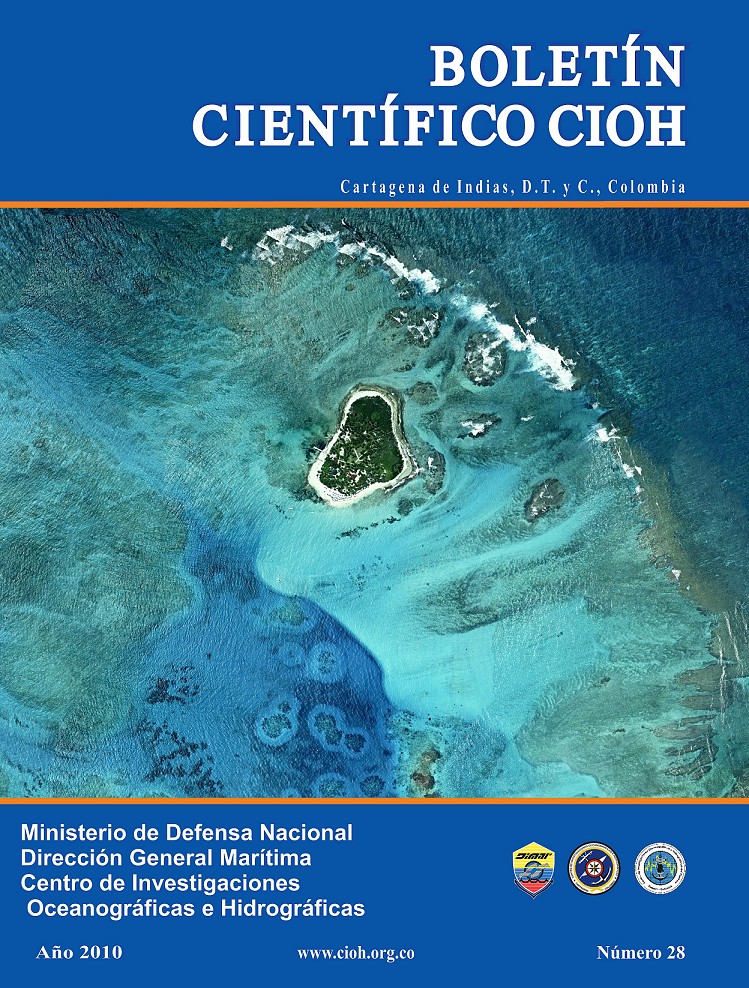Dispersal simulation of queen conch strombus gigas larvae in the Seaflower biosphere reserve, Colombian western Caribbean.
DOI:
https://doi.org/10.26640/22159045.212Keywords:
Queen conch Strombus gigas, larvae dynamics, Colombian Western CaribbeanAbstract
The queen conch, Strombus gigas, endemic of the Caribbean is a specie with decimated populations in most sites of its distribution range, thus subjected to International protection since 2002. Larval dispersal might be an alternative for re-population considering the limited movement of their adults. However, there is little information about abundance and movement patterns of their larvae across the atolls in the Seaflower Biosphere Reserve (BR), one of the few regions with still abundant conch populations. In this study the dynamics of the queen conch larvalDownloads
References
[2] Paris CB, Cherubin LM and RK Cowen. Surfing, spinning, or diving from reef to reef: effects on population connectivity. Marine Ecology Progress Series, 2007; 285-300.
[3] Theile S. Queen conch fisheries and their Management in the Caribbean. Review of significant trade in specimens of appendix II species. Traffic report to CITES. 2001; 95p.
[4] Prada MC, Casto ER, Taylor EJ, Puentes V, Appelddorn RS and Daves N. Non detriment findings for the queen conch (Strombus gigas) in Colombia. San Andres Island. 2009; 51p.
[5] Chiquillo E, Ospina J y Gallo J. Aspectos biológicos del caracol de pala Strombus gigas (linneaus 1975) en el departamento archipiélago de San Andrés, Providencia y Santa Catalina (Caribe colombiano). Informe final. 1997; 17 p.
[6] Appeldoorn RS, Arango L, Cabeza F, Castro-González ER, Glazer R, Marshak T and Peñaloza G. Queen Conch Distribution and Population Assessment of the Northern Banks of the San Andrés Archipelago, Colombia. Unpublished Technical Report. CORALINA, San Andrés Island. 2003; 36p.
[7] McCarthy K. A Review of Queen Conch (Strombus gigas) Lifehistory. NOAA SEDAR 14 DW 4. 2007; 8p.
[8] Blumberg AF y Mellor GL. A description of a three-dimensional coastal ocean circulation model, in Three-Dimensional-Coastal-Ocean-Model. 1987. Heaps American Geophysical Union. Washington, D. C., 1987; 4: 1-16.
[9] Lonin SA. Empleo de los datos de la NOAA-NODC-WOA en el modelo hidrodinámico del Caribe. Boletín Científico CIOH, 2004; (22):45-55.
[10] Lonin SA, Hernández JL, Palacios DM. Atmospheric events disrupting coastal upwelling in the southern Caribbean. J. Geophys. Res. 2010; 115: 17p. doi: 10.1029/2008JC005100.
[11] Davis. M. 1994. Short-term competence in larvae of queen conch Strombus gigas: shifts in behavior, morphology and metamorphic response. Mar. Ecol. Prog. Ser.104:101-108.
[12] Lonin SA. Lagrangian model for oil spill diffusion at sea. Spill Science & Technology Bulletin, 1999; 5: 331-336.
[13] Monin AS and Yaglom AM. Statistical Fluid Mechanics, Lumley, JL (Ed.) Volume 2: Mechanics of turbulence. Cambridge, Mass. MIT Press. 1971;874p.
Downloads
Published
Issue
Section
License
Attribution — You must give appropriate credit, provide a link to the license, and indicate if changes were made. You may do so in any reasonable manner, but not in any way that suggests the licensor endorses you or your use.
NonCommercial — You may not use the material for commercial purposes.
NoDerivatives — If you remix, transform, or build upon the material, you may not distribute the modified material.
No additional restrictions — You may not apply legal terms or technological measures that legally restrict others from doing anything the license permits.



